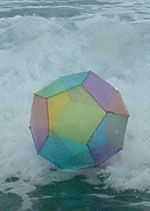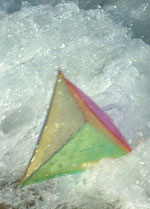|
|

Dodecahedron |

Icosahedron |

Cube and Octahedron |

Tetrahedron |
|
My pages for the Platonic solids are going to be very simple.
You will see the structures being tossed around
by ocean waves and floating in marine tanks. The dodecahedron and icosahedron: both have 30 edges.
With 20 vertices (vertex) and only 3 edges meeting at each of them, the dodecahedron comes closest
to the volume of a sphere and appears to have the "softest" movements in breaking waves. Next is the icosahedron:
with 5 edges
meeting at each of 12 vertex, it is further from the shape of a sphere and
its movements are more dramatic. A reference from a paper
here
relates that the icosahedron rolls the easiest, and there are many such references. There is no doubt
that if sitting on a table, or riding out a swell,
the pentagon faces of the dodecahedron are going to stay put over the icosahedron hands down.
In breaking
waves, however, the dodecahedron appeared to me to be as active as the
icosahedron. The cube and octahedron: both have 12 edges.
The cube, with its 90 degree angles,
topples about and looks comical. The octahedron
doesn't have the bluntness of the cube, so it isn't awkward,
nor does it seem to twirl and spin around like its more spherical counterparts. The tetrahedron, stable
and able to stay on one
face the easiest, elegantly glides flat with edge-on orientation
as though surfing, analogous to tetrahedral
kites
soaring through the sky.
Dodecahedron
Of course the degree of inflation (the structures are inflatables) makes a difference, and the intensity of
the waves. What I have relayed is based on the experience of photographing them in real time and
later looking at the photos, it is all heuristic, no research. What
I need to do next time is videotape them in waves to examine movement over time instead of depending on unreliable
memory and photographic stills.
A question to consider is whether the same properties that hold true on a sturdy, flat surface, will
remain true in turbulent water. One would think yes, and yet I watched what I recall to be a very active dodecahedron in
breaking waves, not just once, or for one day, but on many different days, in spite of the fact that if "rolled" on a
sturdy table, the
dodecahedron would tend toward quickly landing on a face and staying there. On sand with a
breeze behind it, the icosahedron gets away much faster than the dodecahedron. I had to chase
them both down several times when they were sitting together on the sand.
|
| If you have questions about the pictures, please visit my FAQ page or contact me by email. |
|
The image on this web page is © Copyright Gayla Chandler. Permission must be sought for all but personal use for study or enjoyment. |